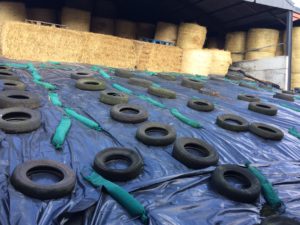Feed Budgeting Before It’s Too Late
18 October 2017 The poor weather over the past few months has caused many farms to house stock earlier than anticipated. It has also hampered silage making efforts, resulting in some farms having lower forage stocks than usual. Going forward into winter it is essential to know you have enough forage to see the stock through until next spring.
The poor weather over the past few months has caused many farms to house stock earlier than anticipated. It has also hampered silage making efforts, resulting in some farms having lower forage stocks than usual. Going forward into winter it is essential to know you have enough forage to see the stock through until next spring.
Supply
The first issue is supply of feed. Calculate how much silage there is for the winter. Having marks on a silage pit wall is a good way to assess how quickly a pit is being used. Having silage analysed regularly is vital to know the dry matter of the silage. This allows rations to be altered to use the forage required to meeting performance targets.
Next the pit needs to be measured to calculate the volume in cubic metres (length x width x height). Next multiply this fresh weight density (from the table below) and then divide by the dry matter. This will give the total tonnes of dry matter in a pit.
Volume x Density/DM = Dry Matter tonnes
Silage Density (tonnes/m3)
| DM% | Clamp Height | |||
| 2.0 | 2.5 | 3.0 | 4.0 | |
| 20 | 0.780 | 0.840 | 0.890 | 0.950 |
| 25 | 0.690 | 0.730 | 0.775 | 0.830 |
| 30 | 0.620 | 0.660 | 0.690 | 0.740 |
| 35 | 0.570 | 0.600 | 0.625 | 0.670 |
| 40+ | 0.520 | 0.550 | 0.570 | 0.610 |
For bales weigh 5 bales. This can be done with weigh cell bars from a crush or in a mixer waggon. Take the average weight of the bales and multiply this by the number of bales. Then divide by dry matter.
Average bale weight x number of bales/DM = Dry matter tonnes
Demand
Having rations made up for all stock will allow accurate feeding of forage stocks and optimise animal performance. Add up the total silage required in a day. Divide this by the total silage in pit. This will give you the number of days of silage available.
If this leaves a shortfall towards the usual turnout date there are a number of options to see you through.
All options should be considered now. Leaving this until January only compounds the issue making the problem worse. If other farms are in the same boat it will also increase the cost of silage to be purchased. 2017 has had one of the wettest summers on record. The other two years with similar summers (1985 and 2012) both had late cold springs in the next year. Perhaps it is worth feed budgeting to allow for this?
Andrew Taylor, andrew.taylor@sac.co.uk
Sign up to the FAS newsletter
Receive updates on news, events and publications from Scotland’s Farm Advisory Service
